Last month, trainer Annie MacDermaid shared tips on how to select an American Mustang to bring home to your herd. This month, she shares the steps she takes to training a mustang horse from wild to mild.
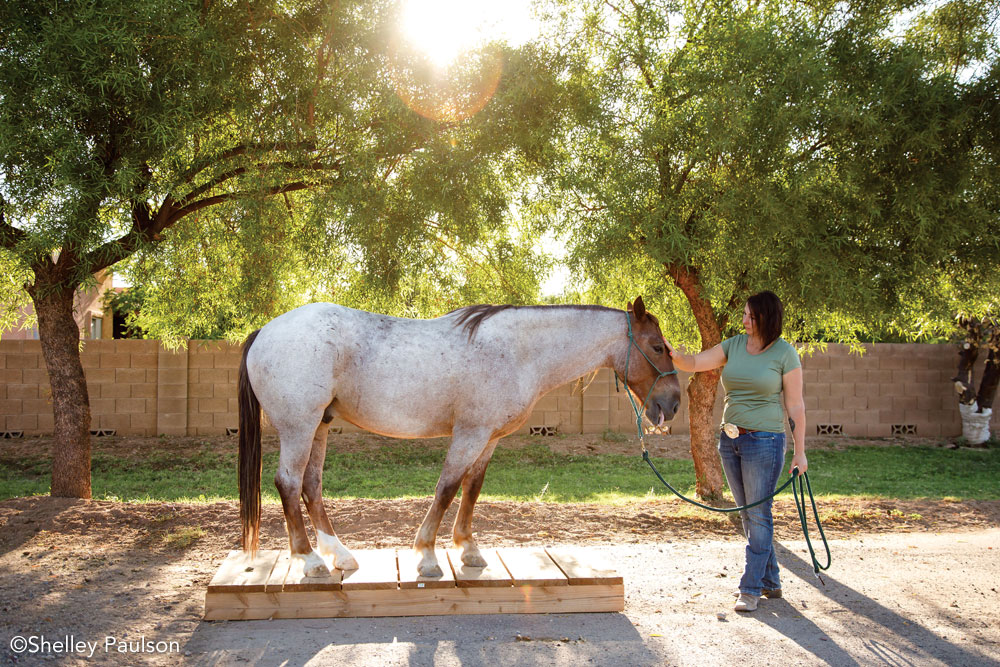
A Strong Foundation
As a Mustang Trainer Incentive Program (TIP) trainer, MacDermaid’s job is to train Mustangs from the BLM pens so they can be safely handled on the ground before being adopted.
MacDermaid believes in laying a strong foundation of groundwork so they are ready to be trained for any discipline under saddle.
“Building a good foundation on a horse is like building a foundation on a house: if you skip blocks or leave holes, your foundation will crumble. But if you take your time and build the foundation properly, the horse will have something to fall back on when faced with difficulty or uncertainty.”
“Building a good foundation on a horse is like building a foundation on a house: if you skip blocks or leave holes, your foundation will crumble,” she says. “But if you take your time and build the foundation properly, the horse will have something to fall back on when faced with difficulty or uncertainty.”
This is excellent advice for any horse owner. While it’s tempting to skip over groundwork and head straight for the saddle, taking your time to build a strong foundation means you won’t have to go back and fix gaps later.
“Eventually, everything on the ground translates to the saddle,” says MacDermaid.
Slow is Fast
The two best things you can bring to a training session with any horse are patience and understanding. “Become a student of the horse,” says MacDermaid. “Every horse is going to react to you and to your training differently because each one is a unique individual. Just as with humans, horses have different personalities and learning styles, so it may take some time for you to determine how your horse learns best.”
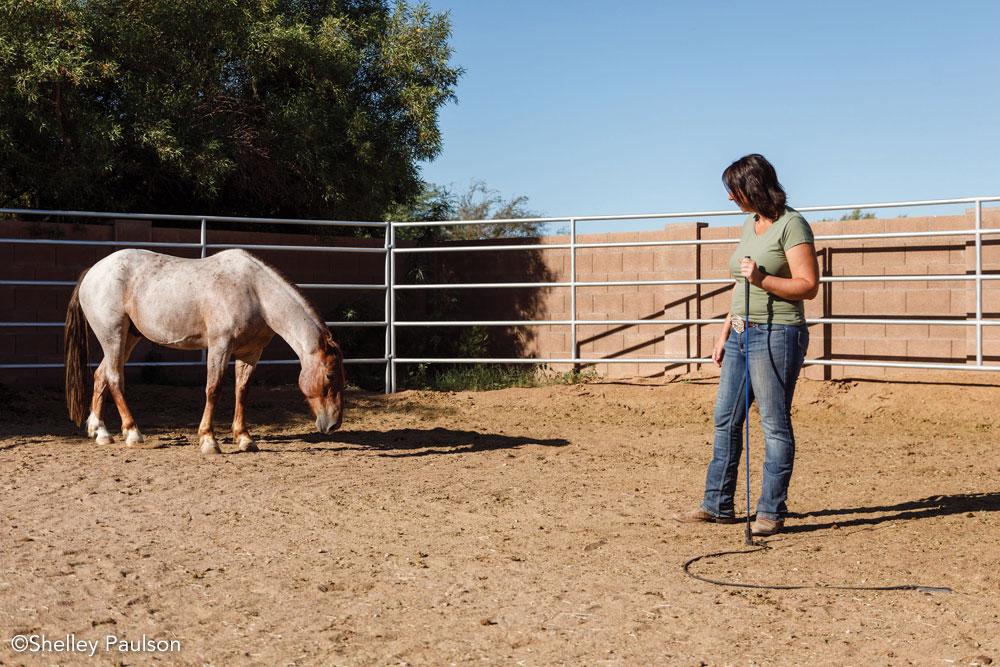
Before starting any type of training program, it’s good to establish realistic goals. While MacDermaid sets goals for each horse, she doesn’t set a specific timeline for reaching them. This allows her to let the horse set the pace of learning.
MacDermaid’s basic goals for her TIP horses are as follows:
- Catching and haltering
- Leading and tying
- Grooming and hoof handling
- Trailer loading and unloading
If you do plan to train a Mustang at home, you should be able to devote a minimum of one hour a day, five days a week.
“There is no substitute for time invested,” MacDermaid tells her clients. “You will get back what you put in.”
She also emphasizes that training Mustangs, in particular, is a huge undertaking and there is no shame in asking for help from professionals if you get stuck.
Establish and Maintain Boundaries
Horses are herd animals and are always looking for a leader. If you are not the leader they will take on that role, which can lead to the development of unwanted or even dangerous behaviors.
With any horse, it is essential to establish yourself as the leader in the relationship. With wild horses, this is even more critical.
“Wild horses need to be taught how to interact with humans,” says MacDermaid. “In the wild, they may bite or kick each other, but that’s not safe with humans. We don’t want them treating us like another horse.”
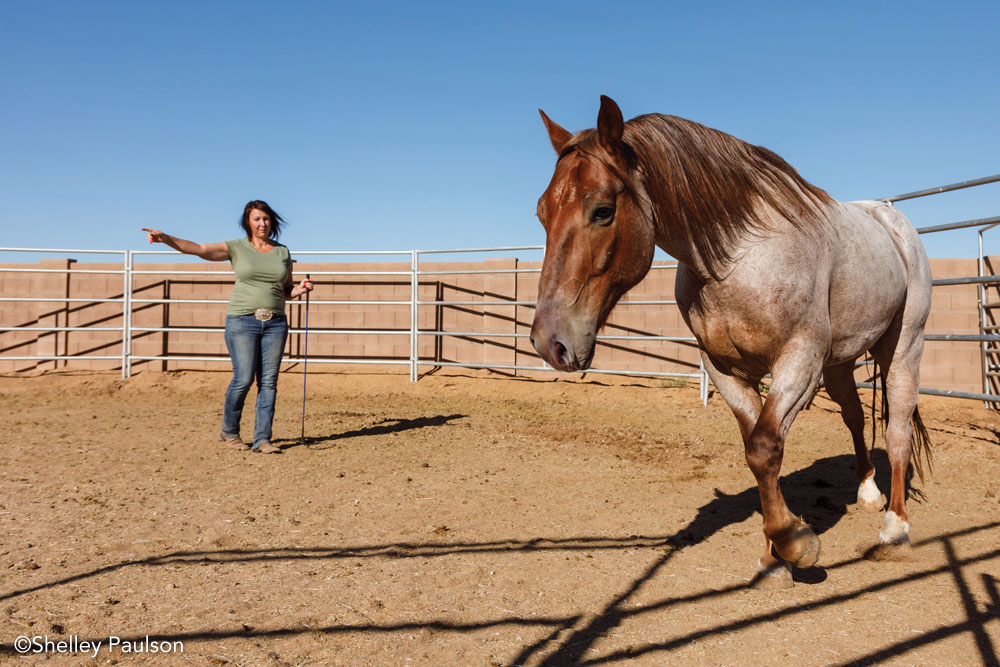
This doesn’t mean that you become a harsh dictator and dominate your horse into submission. “Keep in mind that your desired relationship with the horse is a partnership, so be clear, kind, firm, and fair.”
MacDermaid recommends starting by creating a consistent physical boundary with your horse. The primary reason for this is safety. If a horse is in close proximity to you and is startled or pushed by another horse, you could get caught up in the shuffle and get hurt. The extra space also allows you the room to redirect his feet if you need to.
The boundary you set should stay the same whether you are training or interacting with the horse outside of the training session.
“If you bring a horse into your personal space for treats and petting, but correct him for being that close when you are training, then he can get confused,” says MacDermaid. She likes to keep a full arm’s length away because she is mostly dealing with wild horses, but the boundary for a domestic horse might be less and will depend on personal preference.
Round Pen with a Purpose
A round pen is an ideal environment for training horses, especially those that have never been handled. You may not be able to actually halter a wild or untrained horse right away, but with a round pen, you have a safe, secure environment where you can start training immediately.
If you don’t have access to a round pen, and your horse is already halter trained, some of these steps can also be done on a longeline.
The purpose of working with a horse in the round pen is not to tire him out, but rather to establish communication, build a solid relationship, and help the horse learn to trust you and accept you as a leader.
For MacDermaid, the purpose of working with a horse in the round pen is not to tire him out, but rather to establish communication, build a solid relationship, and help the horse learn to trust you and accept you as a leader.
Getting a horse’s feet moving gets him thinking and focused on you. It doesn’t matter how fast he moves as long as he is moving his feet.
“I love doing slow work,” says MacDermaid. “It’s easier to bring the energy up on a wild horse, so I focus on getting him to relax in the pen.”
Signs of Relaxation
Learn how to identify the signs of a relaxed horse:
- Head drop
- Licking and chewing
- Blinking
- Ear in
- Glance
- Relaxed frame
- Sigh
When entering the round pen with a horse, MacDermaid says you should pay attention to the horse’s energy level. If you think of energy in terms of a scale of 1 to 10, and the horse’s energy is at a 7, you need to keep yours at a 3.
The most essential thing to learn when working with a horse in the round pen is when to release pressure.
“You need to know what you are asking for in order to release properly,” says MacDermaid. “Release your pressure when you get the desired result from what you asked the horse to do. Too soon or too late and the lesson can be ineffective.”
Her main goal in the round pen is to gain control of the horse’s body. She starts by establishing the direction she wants the horse to go by focusing her body and energy on the horse’s hindquarters and then pointing to where she wants him to go. Pointing is key because it translates later to working with the horse in a halter. She uses the pointing gesture to send them forward over an obstacle, through a gate or into the trailer.
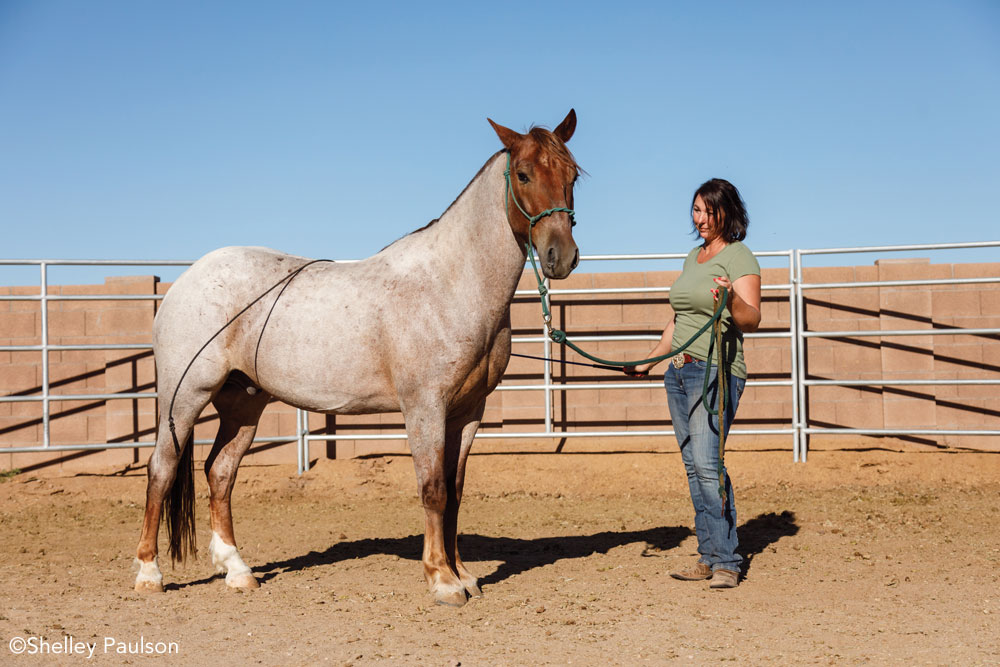
To ask the horse to stop, she puts her body at a 45-degree angle to the horse’s shoulders, steps in front of his driveline, and says “whoa.” When he stops and turns in to her, she releases the pressure by taking a few steps away from the horse. This allows him to relax and let the lesson sink in before moving on. She repeats this process in each direction.
“It’s important that you don’t move on to the second step until the horse has learned the first step, just like you don’t teach a child to walk until they can crawl.”
Haltering and Leading
After MacDermaid has good control over the horse’s body, she moves on to working with him in a halter.
“Still in the round pen, I start by desensitizing him to being touched using a stick with a string on the end,” she explains. “I let the string lie across his back, shoulders and around his legs so he gets used to being touched by it.”
Once he no longer reacts to the stick and string, she approaches him for haltering. Because a strong foundation has been established through round pen work, the horse usually accepts the halter without much resistance.
The next step is to teach the horse to lead at the end of a rope. MacDermaid’s approach is to teach him to “send” (move forward without pressure while holding the rope and encouraging him to step forward) rather than by dragging the horse forward on a lead rope.
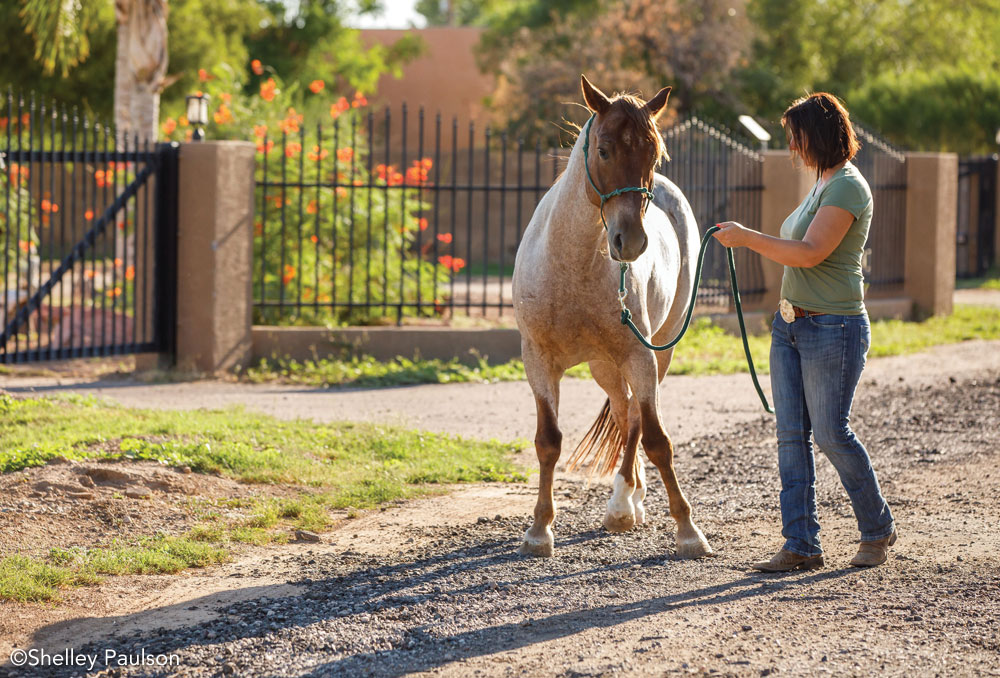
“It’s key to understand that horses don’t learn from pressure but from the release of pressure,” she says. “When teaching a horse to send or lead, reward even the slightest try.”
Once a horse has learned to send, it’s easy to transition him to willingly walking next to you on the lead rope.
Another concept MacDermaid teaches horses before she leaves the round pen is to stand tied for long periods of time. She will leave a horse safely tied and monitored for one to two hours. Tying teaches a horse good life skills such as patience, confidence and independence. There are many scenarios in a horse’s life (competitions, trailering long distances, camping trips) where he will need to stand tied for hours at a time.
Building Confidence
Once MacDermaid is comfortable with handling a horse in the round pen, she takes him out into the world and begins to build his confidence through desensitization. She likes to teach horses to walk on different surfaces by going over obstacles like a wooden bridge, a tarp and water. She uses the “send” skill she taught the horse in the round pen to ask him to go over the obstacle while keeping herself where she can control his body.
“Don’t be afraid to make mistakes. Sometimes you have to step back and try something else.”
She also introduces horses to unusual objects like pool noodles, umbrellas and giant stuffed animals.
“I’m not trying to desensitize a horse to a specific object. You may never come across a pool noodle on the trail, but you’re teaching him to learn how to handle himself in novel and stressful situations,” says MacDermaid.
If there’s one thing she has learned over her years of training Mustangs, it’s that there is always more to learn.
“Don’t be afraid to make mistakes,” she says. “Sometimes you have to step back and try something else.” She regularly attends clinics, reads books and seeks help from others if she gets stuck.
While training a Mustang might not be for everyone, taking the time to lay a strong foundation on the ground with any horse will ensure you create a safe and willing partner in the saddle.
Trainer’s Toolkit
Round Pen
Mustang trainer Annie MacDermaid prefers a 40-foot wide round pen. Anything larger creates more work; a smaller one doesn’t allow a safe distance from the horse.
Rope Halter
Rope halters send clearer communication to the horse because they create more direct pressure than a flat halter.
14-Foot Cotton line
If you have to send the horse, you can maintain control with a 14-foot lead rope. It’s also easier to regain control and maintain a safe distance.
Stick and String
To be used as an extension of your arm and for desensitizing, not for force or punishment. Sometimes the first touch is with the stick and string, not with the hand.
This article originally appeared in the March 2019 issue of Horse Illustrated magazine. Click here to subscribe!


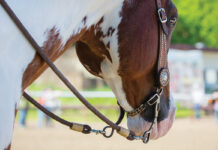
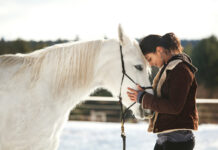


[…] Horse Illustrated submitted the Mustang Training series I wrote and photographed in 2019, which featured my friend Annie MacDermaid. It came in 2nd out of 22 entries! FOR WRITING! I never think of myself as a writer, but I think that needs to change. You can read the articles online: Out of the Wild Part 1: Mustang Matchmaker | Out of the Wild Part 2: Think Like a Mustang Trainer […]
Hi Shelley,
What issues of Horse Illustrated are the mustang articles with your friend?? I’d like to order back issues.